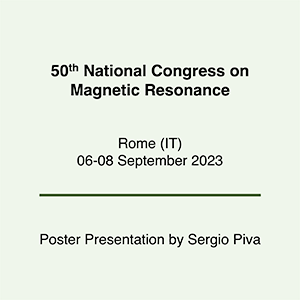Rome (Italy), 06-08 September 2023, Poster Presentation by Sergio Piva
Title: “Complete Investigation of Fluorinated MOF Comprising Dipolar Molecular Rotors by Solid-State NMR”
Authors: S. Piva, S. Bracco, J. Perego, C. X. Bezuidenhout, A. Daolio and A. Comotti
Abstract
The design of solid materials comprising rotors that can convert external stimuli into actions is growing exponentially. [1] In particular, the incorporation of fast-reorientating dipoles onto molecular rotors is very attractive for the fabrication of materials responsive to oscillating or static electric fields. In this work, we successfully synthetized two new isostructural aluminum-based metal-organic frameworks (MOFs), endowing bicyclopentanedicarboxylate molecular rotors as linkers, denominated frustrated trigonal rotors (FTR), in the hydrogenated and partly fluorinated derivatives (FTR-F2). [2] Multi-nuclear high-resolution ssNMR techniques were used to characterize the new crystal structures, demonstrating the purity and symmetry of the materials. The empty space that surrounds the rotors allowing them to move freely was directly probed with continuous-flow hyperpolarized (HP) 129Xe NMR. The observed chemical shift anisotropy (see Fig. 1 Left) indicates that the xenon is exploring an ellipsoidal cross-section, as observed in the rhombohedral structure of the framework. 1H T1 relaxation times were collected down to 2 K (see Fig.1, Right) in order to understand the motional behavior of the molecular rotors having CF2 groups mounted, which were proved hyper-mobile even at such low temperatures with extremely low activation energies for dipole reorientation. In particular, the T1 revealed multiple relaxation phenomena due to correlated dipole-rotor configurations. The discovery paved the way for the realization of dipolar rotors unaffected by thermal noise to be used inmolecular machines with low energy dissipation and controllable dynamics. [1] J. Perego, C. X. Bezuidenhout, S. Bracco, G. Prando, et al. J. Am. Chem. Soc. 2021 143 (33), 13082-13090 [2] J. Perego, C. X. Bezuidenhout, S. Bracco, S. Piva, et al. Angew. Chem. Int. Ed. 2023, 62, e202215893

